
|   |

|   |
 e-mail: leelakaverivenkat@gmail.com IIC Experience celebrates the lived traditions of South India in Dakshinayan Photos courtesy: IIC November 21, 2023 Changing tack from its usual all India approach, India International Centre's celebration of its signature festival the IIC EXPERIENCE, this year in DAKSHINAYAN, put the searchlight solely on lived traditions of South India. Starting with a journey in the Art Gallery of Kamaladevi Complex on Chettinad -An Enduring Legacy (from the collection of RM Cultural Foundation, Chennai) focusing on history and heritage of this highly evolved community known for their art patronage, with a peep into the symbolism of clan temples and majestic homes of Chettiars, to Conference Room I which was the venue for an exhibition 'of texts, reproductions of archival photographs, facsimiles of rare books, digitized copies of manuscripts and other digital reproductions' from the collection of the Connemara Public Library, Chennai, on to the open grounds of Gandhi- King Plaza where Stories from the Earth comprising Terracotta Narratives, exhibited select pieces from the Sanskriti Museum of Indian Terracotta from earthen pot for drinking water to equestrian figures of the Ayyanar cult of rural Tamil Nadu. It was a plethora of projections on and from India's South. The performance side presented at Deshmukh Auditorium and the Fountain Lawns with Mohiniattam and Kathakali presentations from Kerala, Tholu Bommalata Puppet Theatre from Andhra Pradesh, the imaginatively conceptualized Kshetra Prema: Stories from Temples of South India, and Carnatic vocal recital by N. Vijay Siva, pretty much covered all States of the South. And what a fine idea to project one part of India in some detail, instead of, grasshopper like, flitting across several areas! 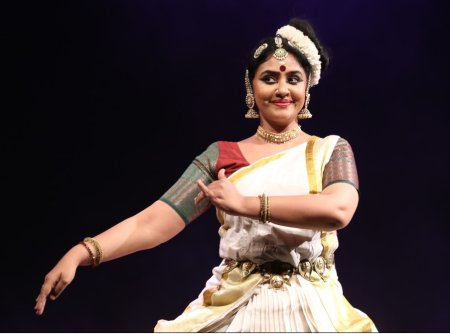 Methil Devika Dr. Methil Devika's Mohiniattam is characterized by subtlety with an unerring feel for aesthetics. The very individualistic approach in her work stems from an intellectual bent of mind coupled with a thirst for research, with a natural curiosity for delving into religious philosophy, often used as thematic matter in her productions. The presentation with her students on the open air stage on the Fountain Lawns began with a Chollukettu, with a verse from Adi Shankara's Saundarya Lahiri (8th century CE) with salutations to Shiva/Shakti - Shakti or the Goddess as the primordial cosmic energy with Shiva as substratum - the work also expounding on the Tantric esoteric. Expressive, and not given to an exuberance of nritta, the curtain raiser in Methil Devika's approach, had the swaying bodies, male and female, performing as they entered in unhurried grace, to the syllables tam tam tattunga..... dhirikitataka as the slow, curling notes of sur filled Sopanam music filled the air. The next item introducing a dramatic element, was built round the familiar Kerala anecdote surrounding Manaveda, the Samuthiri of Kozhikode (Zamorin of Calicut), whose ardent desire to be able to see child Krishna, made him request the spiritually empowered Vilwamangalaswamy, believed to be visited by the divine child regularly, that he be granted a glimpse of the God child. After seeking Guruvayurappan's permission, Vilwamangalaswamy informed the Zamorin that in the wee hours of the morning he could catch a glimpse of Krishna playing under the Elanji tree. Wonder- struck by what he was seeing, the Samuthiri, forgetting himself, rushed to embrace the child upon which Krishna immediately vanished leaving behind a peacock feather worn in his crown. Manaveda composed his famous work Krishnageethi in 1652, which in eight chapters deals with various aspects of Krishna's life from birth to the end. And based on this work is Krishnattam, the dance drama, even today occupying the status of an offering, staged regularly in the Guruvayurappan temple koothambalam. The actor as Krishna wears the peacock feather, believed to have been left behind by the hurriedly vanishing child Krishna from Manaveda's view. As the narrative was presented, Methil's expressional transformation portraying the mingled wonder and exultation of the Samuthiri as he set eyes on the God child (kandu vismaicho...), was a high point. Some believe that the koothambalam in Guruvayur is the place where Vilwamangalaswamiyar's illam stood. 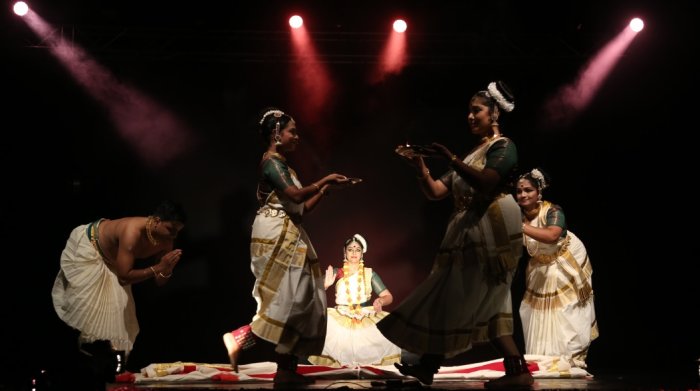 Methil Devika & group Inspired by Pragya Paramita Buddhist Sutra, was the dancer's next group presentation. When Shariputra (Buddha's main disciple) and his disciples questioned Buddha after he had attained nirvana about whether he was in sorrow or happiness, the master's answer that he felt neither state, underlined the fact that dualism arising from cause and its effect, and polarities, find no place at all in the void and shoonyata of constant awareness, encompassing only compassion and equanimity. What one found noteworthy was that the syllables of Buddhist chanting, set to raga music in keeping with the dance, seemed evocative of both the Mohiniattam gait and Buddhist chanting cadence. The finale was on a note of pure theatre, embracing Kerala which has several rich traditions starting form Ottam Thullal to Chakyar Koothu, Koodiyattam, Kathakali etc. The theme was based on the well-known story of Uchhila, a young Brahmin girl in the village of Perinchellur, whose high intelligence and learning tickled the jealousy of the Gurukkal presiding over all Vedic matters. So, prior to her betrothal, plotting to put to test her Vedic knowledge, they questioned her on answering what gave the greatest pleasure, and what caused the greatest physical pain. Uchhila's answers mentioning sringar union as the act of highest pleasure and pangs of childbirth as causing the greatest physical pain, led to her being ostracized from society by the Gurukkal - who questioned the moral turpitude of this unmarried girl. Without experiencing, how could she answer these questions with such authority? Taking refuge in a Shiva temple in Karivellur, Uchhila decided on self-immolation. Half burnt due to shortage of firewood, she asked a passing Vaniya to pour coconut oil on the pyre to hasten her death. Blessed by Shiva, she is believed to have reincarnated on Earth as Goddess Muchilot Bhagavati, the Goddess worshipped by the Vanniyas. Muchilot Bhagavati comprises one of the most elaborate Theyyam performances. It was interesting to see Methil Devika's choreography where the question and answer scene had an actor as Chakyar - very fitting because the Chakyars hailed from the Namboothiri community most dominant in this village. The persons involved in framing all these anecdotes into literary expressions for the dance, and those composing the music, also need to be lauded. BRILLIANT KATHAKALI EXPRESSION OF DON QUIXOTE Kathakali as a performance has found minimal space in an IIC Festival, and to decide on Thiruvananthapuram Margi's presentation of scenes from Don Quixote based on the most translated Spanish epic novel of Miguel de Cervantes (written in 1605 with the second part in 1610) as a full-fledged evening performance, seemed like leap frogging into the contemporary phase of Kathakali, before familiarizing oneself with its traditional incarnations. But for a mixed Delhi audience, this version scripted and directed by P.Venugopalan, was an excellent choice, providing a perfect example of how age old performing art traditions in India have shown the resilience of being able to adapt to themes inspired by world literature, without forsaking their innate identity. An exotic art form like Kathakali has seen some riveting versions of Shakespeare's Othello, or Macbeth. Wonderful way of exposing the riches of one culture to another! 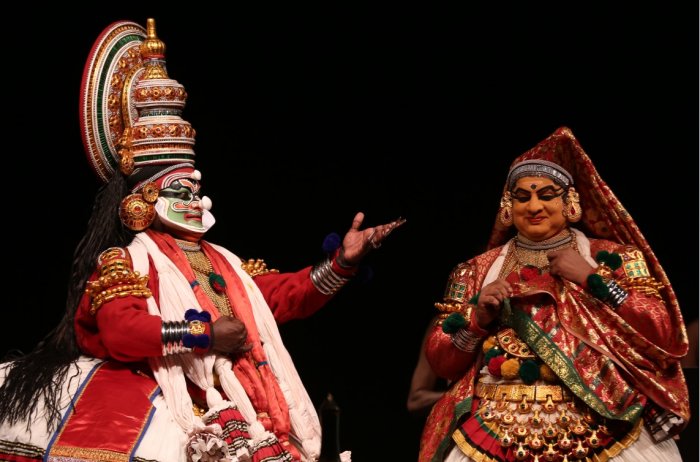 Don Quixote Transporting the earthy wit of a work like Don Quixote into a quixotic Kathakali presentation, requires an aata prakaram (acting script manual) comprising complete understanding of the inner nature of both the novel and of Kathakali. An hidalgo from La Mancha belonging to lowest of Spanish nobility, obsessed by chivalrous acts touted in books, after reading a novel, decides to change his persona into Alonso Quijano, intent on a life of reviving chivalry and salvation. Naming his skinny, old work horse Rocinate, and convincing a down-to- earth peasant Sancho Panza, to accompany him as his Squire, along with his mule Dapple, he sets off on an adventure to restore the age of chivalry in aid of society - strangely unafraid of being hurt and not expecting rewards in return. Imagining a delightfully beautiful Dulcinea in a rusty slaughter house worker (as his beloved), his encounters in battling supposed devils and knights ready to attack him in traders from Toledo, and even working windmills, not to speak of daring to fight a lion - leave Quixote mentally defeated and physically hurt. He finally returns home to nurse a bruised body and before breathing his last, realization hits him that his world is vastly different and that salvation lies within himself. Sancho Panza on the other hand, while a temporary participant in a life of illusion, never forsakes reality, and is comfortable in getting back to his old farm days. The Kathakali adaptation slots different roles into characteristic traditional types. The contrast between the real Alonso Quijano and his hallucinating self, masquerading as Don Quixote a knight, was emphatically brought out by casting the former in a natural vellai tadi (white bearded) role in short pyjamas with a top and with a typical hat as headdress, while the latter was cast in typical kathi vesham, turned out in the voluminous skirt with a tight top, with bulbous nose, and fangs bared once in a way, while playing knighthood. Sakha Sancho Panza was shown as a minukku character, with natural makeup, turned out in dhoti with bare top with the crisscrossed angavastram. The two windmills were represented in two stationary sevappu tadi (red bearded) characters slowly rolling arms like blades of a wind mill. Carrasco was the pacha character with green makeup, who has the better of Quixote, who, falling from his horse, acknowledges having lost the battle for knighthood and chivalry. 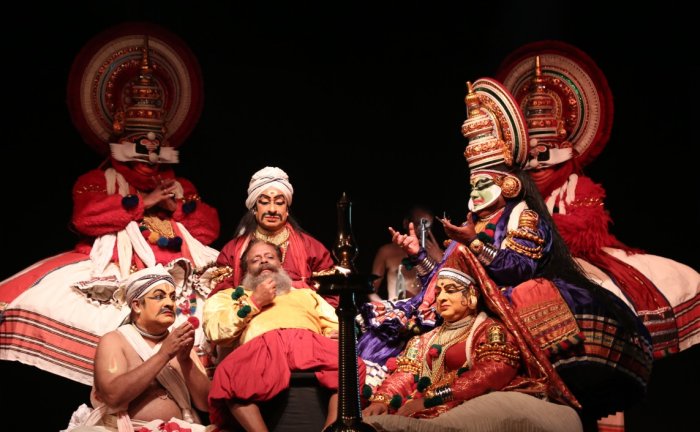 Don Quixote (dying scene) After lighting the lamp, the play starts with a seated Kalamandalam Ratheeson, vibrantly communicative as Alonso Quijano, presenting ilakkiyattam (improvised abhinaya) to the accompaniment of soft chenda and maddalam percussion, showing one lost in an imagined world of chivalrous deeds touted in books. And gradually, for an addled mind, the illusionary world becomes more real. The actor's ability for interpretative dance became evident when he appeared again in the finale of the unusually prolonged death scene for Kathakali (If Bali in Koodiyattam can take forty five minutes dying on stage, why not Alonso in Don Quixote, would seem to be the argument). Pin drop silence in the audience, along with the odd wet eye, showed the emotional poignancy of this masterpiece of a scene. As Quixote, Kalamandalam Pradeep, even amidst the foolhardy acts of utter senselessness, preserved a measure of dignity in the character. Right from the tirainokku entrance behind the curtain, to execution of the powerful kalasams (nrittsa interludes) while taking belligerent stances as a knight provoking battle - all contrasting with the soft endearments in the sringar scene exchanged with Dulcinea (Margi Sukumaran in stree vesham) with the disappointment of an undignified fall from his horse, resulting in the decision to end this adventure, his was a role in manifold moods. Very endearing and easily stealing the thunder, was Margi Vijayakumar in the droll role of Sancho Panza. Margi Balasubramaniam as the knight was effective and in smaller roles were Margi Ravindran Nair as cart driver, Kalamandalam Atul as the lion which refuses to fight, and Sadanam Parthasarathy and Sadanam Vishnuprasad as the windmills. Evocative and very melodious and of a piece with the acting, was the accompaniment in the Sopana singing style of the Carnatic ragas like Bhairavi, Todi, Attana, Madhyamavati et al by the singers Pathiyoor Sankarankutty and Kalamandalam Baiju, with the excellent support of Kalamandalam Krishnadas on chenda and Margi Ratnakaran on the maddalam. But for me, the really potent part lay in the deep, pregnant silences - speaking more powerfully than words. INSPIRING THOLU BOMMALATA Tholu Bommalata, the leather puppet art of Andhra Pradesh/Telangana, presented by Chidambara Rao and puppet artists of Sarmaya from Andhra Pradesh / Telangana screened the very popular Lanka Dahanam (burning of Lanka). An ancient tradition which is believed to have started sometime in the Satavahana period, the art of leather puppets is said to have spread from here to many countries of South East Asia. Today puppets are mostly made of goat skin from dead animals not killed for the purpose, and the old practice of elevated characters being made of deer skin has been discontinued with hunting of these animals stopped. Some three feet in height, these leather puppets, with more joints than their counterpart Thogalu Bommalata in adjoining Karnataka, are purported to be capable of greater mobility. These leather puppets seem to enlarge and shrink in size, suddenly appear on the scene from nowhere and just as quickly fade out without a trace. While hands and head move constantly with the manipulation of threads by which they are held in place by the puppeteer, the way a character like that of Hanuman sways from the hip, flies in the air and moves with lighting speed makes the fighting scene with the rakshasas very real, and showed how dexterously the puppeteers wield them. 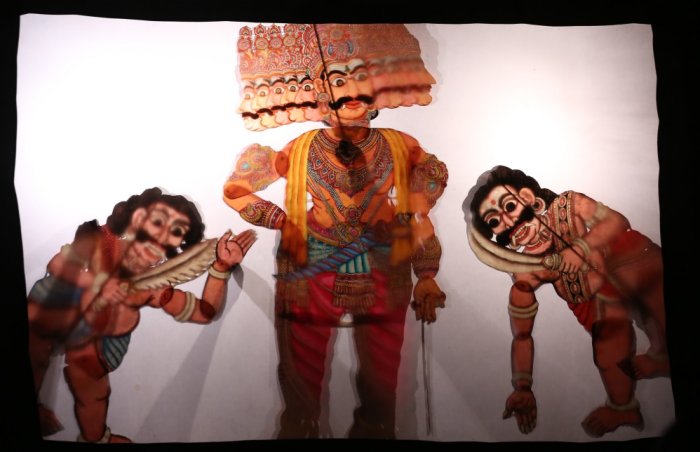 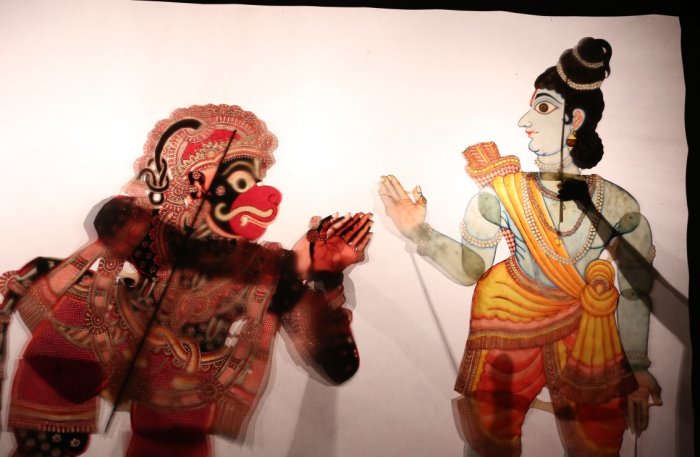 Tholu Bommalata The dialogue in Telugu has a style of rendition (with puppeteers singing the lines of their respective character) which sounds typically like some of the singing for Kuchipudi. Chidambara Rao from Dharmavaram, director and lead male, along with inspiration from tradition has experimented with colour and form, showing innovative zeal. He had with him Viranjineyulu, Chinna Anjamma (female lead), Sindhe Srinivasulu (puppetry) along with Dalavai Kulkayappe (puppetry). The music was provided by Sindhe Chinna Venkatramana on harmonium, Sindhe Kulkeyappa on the mridangam, and Sindhe Venkatramana providing the female chorus. IMAGINATIVE KSHETRA PREMA By far the most imaginative part of this festival, as almost all members felt, came from Kshetra Prema comprising stories from South Indian temples - and whoever thought of including this as a part of the week long fare, deserves to be congratulated. With involved narration by Vinay Varanasi and the most lilting vocal support by Vivek Sadasivam, the program tellingly brought out how the temple deity was not a distant divinity inspiring arts like sculpture, music, dance, painting et al but the fulcrum of a culture, round which life in the temple town revolved. Kshetras with their sthalapuranas and anecdotes pertaining to each, show how the community round a temple town relate with a very personalized divinity in the temple abode. These temple anecdotes show the bond knitting people together, rising above differences of caste, creed and community. Starting with the Tirupati temple and the episode of Anantalwar and why the chin of God Venkateshwara is smeared with camphor, one knows of the vaggeyakara Annamacharya with prolific compositions of music and poetry in praise of the Lord. The story of Bhadrachalam Ramdas, the vaggeyakara (whose devotional kirtanas, mostly in Telugu, some in Sanskrit and a few in Tamil are an important part of Carnatic music) centered round the temple in the village parnasala, where Rama and Sita during exile are believed to have lived for some time.  Kshetra Prema Addressed to Rama are compositions to free him from solitary confinement (during the Qutub Shahi rule for twelve years), a joint appeal also being addressed to Sita, with the compositions melodiously rendered, Ikshvaku kula Tilaka in raga Yadukula Kambodi, and Seetamma Mayamma in raga Vasantha. Very interesting was the anecdote centered round the Munch Muruga temple in Alappuzha in Kerala, where the prasad for the Lord includes chapathi roti - attributed to the tale of the Muslim boy in the village who ringing the temple bell had made the offering of Munch to the God! And in tune with God Muruga, the musical expression came with a Kavadichindu! And who has not heard of the story of Bibi Thuluka (Thuluka Nachiyar) and the feelings she developed for the stolen procession idol (Arangan) of the famous Ranganatha temple of Srirangam? Carted away from its hidden place during the attack on the temple by Malik Kafur in about 1311 AD, the idol was traced to the Delhi Sultanate. After being won over through music which was the Sultan's weak point, he granted permission for the stolen idol to be returned to the rightful priests. But the idol was in daughter Bibi Thuluka's possession and she had developed feelings for it and was not willing to part with it. The decision to go to Srirangam to stay beside the lord resulted in her death, after which, her association with the deity has become permanent as the revered Bibi Nachiyar to this day. The composition Parimala Ranganathan in the melting notes of Hamir Kalyani was soulfully rendered. And many more tales, what with the eloquence of the narrator and the mesmeric singing of the vocalist transported the listener to a different world. Altogether Dakshinayan reflecting on aspects of South India left behind some unique impressions.  Writing on the dance scene for the last forty years, Leela Venkataraman's incisive comments on performances of all dance forms, participation in dance discussions both in India and abroad, and as a regular contributor to Hindu Friday Review, journals like Sruti and Nartanam, makes her voice respected for its balanced critiquing. She is the author of several books like Indian Classical dance: Tradition in Transition, Classical Dance in India and Indian Classical dance: The Renaissance and Beyond. Post your comments Pl provide your name and email id along with your comment. All appropriate comments posted with name and email id in the blog will also be featured in the site. |